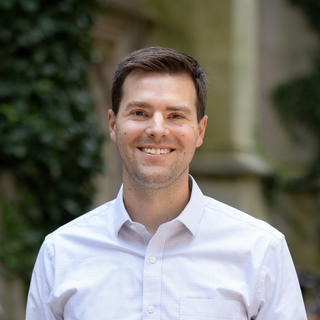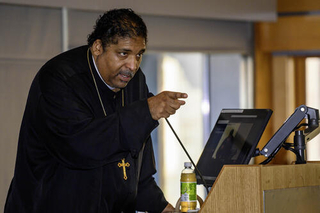Sacred Practices and “Environmental Joy”

ISM Fellow Ryan Darr
Yale Institute of Sacred Music (ISM) fellow Ryan Darr was recently invited to join the planning team for a conference held at Yale in October on “Environmental Joy.” Sponsored by the Yale Center for Environmental Justice (YCEJ) and co-sponsored by the ISM, the conference sought to highlight the crucial role of joy in the fight for environmental justice, especially in a world where there is much lament and fear.
Recognizing the importance of the religious and sacred for the Environmental Joy (EJ) movement, the director of the YCEJ, Michel Gelobter, asked Darr to develop “sacred practices” to include in the conference. Darr teamed up with Yale Drama School doctoral candidate Emily Sorensen whose research focuses on eco-ritual.
Religion and the sacred have always been crucial sources of the EJ movement, from the central role of Black churches in the movement’s rise, to indigenous work centered on the sacrality of land and species.
Together, Darr and Sorensen created a series of sacred practices that attendees were invited to participate in at the beginning of each track session. These varied in structure and content. One centered on play and connection, asking participants to draw sacred and joyful places with crayons and to then contribute to others’ pictures, essentially co-creating places of joy and the sacred. The results were hung on the walls throughout the conference. Another more meditative practice involved participants focusing on their breath and the embodied nature of joy. Participants were also invited to articulate a sankalpa (the Sanskrit word for “intention”) to guide and help them imagine how their EJ work might flow from a place of joy. These intentions were written on sticky notes and posted on a board for all to see.
These practices paired well with other sacred dimensions of the conference, including a talk and performance by the indigenous musician, scholar, and community organizer, Dr. Lyla June, and a keynote by the Reverend William Barber. In the final session, Barber closed out the conference by leading participants in song.
The incorporation of sacred elements into the conference opened up space for deep and wholistic forms of engagement, including deeply emotional moments. One participant commented that this conference may have marked the first occurrence of an intentionally sacred event in Kroon Hall, the home of the Yale School of the Environment. Another participant who works for the city of New Haven asked to borrow the sacred practices for city events. The success of the conference has already led to conversations about how to include more sacred elements in future conferences.
— With contributions from Ryan Darr

Reverend William Barber